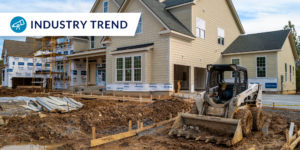
Following a year of substantial growth in the construction sector — construction spending increased by a remarkable 8.2% in 2021 — the end of the year brought a chill to the industry.
In December 2021, construction spending growth slowed to just 0.2% — well below the previous month’s 0.6% — missing many economists’ forecasts of continued strong growth.
While shifting economic factors may contribute to continued bumpy months for construction professionals, incoming federal money is expected to provide a steadying boost to the industry.
With normal supply and demand forces thrown off balance by the global pandemic, the spending in the construction industry has shifted around to different types of projects.
Non-residential projects, for instance, have historically dominated the construction spending mix at around $800 billion per year.
But in 2021, residential spending — which normally sat around $500 billion per year — exploded by nearly 60% to match nonresidential spending for the first time. Low mortgage rates and more people working from home led to a significant increase in the demand for homes.
Home-builders responded in force to this demand: The inventory of available homes surged to 403,000 in December, up 58% from a year ago, and the highest level since 2008.
Inflated prices and restricted supplies made it difficult for builders to complete construction on many homes. Even still, demand was so strong that in November, nearly half of all new homes sold were still under construction, and a quarter hadn’t even been started.
It seems inevitable that such stratospheric activity will inevitably return to Earth. As mortgage rates creep upwards and more employees return to the workplace, the demand for housing may be stifled.
It appears the industry is already preparing for this: With waning demand and a stockpile of homes, some builders are starting to slow construction significantly.
For example, in North Texas, construction permits for new homes dropped by 27% in December, marking five months of declining permit filing.
Despite the fading housing boom, residential spending still rose by 1.1% in December. The overall slowdown is primarily due to a drop in spending on public construction projects, which fell by 1.6% in total. Federal government spending contributed heavily to this, dropping by a worrying 5.4%.
“Public construction was responsible for much of the weakness in December,” said Anirban Basu, Chief Economist of the Associated Builders and Contractors.
Despite the drop in federal spending, many professionals believe public projects will see a rebound in the coming months and years.
“The expectation among many is that, as infrastructure monies begin to flow, the second half of the year will be better than the first,” Basu continued. “It is possible that infrastructure dollars will not begin to forcefully affect the marketplace until 2023.”
As reported by Levelset’s Isaac Barzso, Congress’ recently passed infrastructure bill is slated to pump over a trillion dollars into the nation’s transportation, water facilities, and more. It will take time for funding to trickle down to local projects, but many professionals are optimistic for the future of public projects.
“Despite recent weakness, public construction is poised for stronger growth over the next few years,” said Mark Vitner, senior economist with Wells Fargo Securities. “State and local governments are flush with cash from strong tax receipts and previous rounds of federal aid. Much of this spending is going into street improvements, greenways and streetscapes.”
Like most sectors of the economy, the global pandemic has thrown the construction industry into uncharted territory. Certain sectors of the industry have seen booms, others have seen busts, and it’s likely that this rollercoaster will continue for some time.
Despite these uncertainties, spending in the construction industry is still about 14% above pre-pandemic levels. While many contractors will benefit from the increased spending, it’s always important to consider heightened risk levels associated with high-growth fields and plan accordingly.